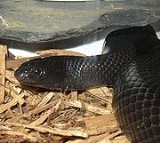
Lampropeltis getula nigrita
Encyclopedia
The Mexican Black Kingsnake (Lampropeltis getula nigrita) is part of the larger colubrid family of snakes, and a subspecies of the common kingsnake, which is debated by herpetologists to contain as many as 10 unique varieties. This species occupy rocky areas and places lush with vegetation in various regions of the Sonora Desert, Northwestern Sinaloa, Mexico, and small parts of Arizona
. In captivity, they can remain in excellent health through a strict diet of mice and generally require a temperature gradient between 70-85 degrees Fahrenheit.
, and while kingsnakes do not possess rattles, they do, however, exhibit the same behaviour. This act is quite common among all the colubrids (such as corn snakes and milk snakes) and is a sign they should be left alone. While some have been known to strike their owners if continued to be agitated during this state, this is rare among the species.
The Mexican Black Kingsnake regularly feeds on other snakes in the wild, such as rattlesnakes (whose venom has little to no effect on them), so it is advisable that they be housed alone.
Because snakes digest nearly all of their prey, they do not require additional sources of vitamins or minerals. Moreover, at this time, there exists no data to suggest otherwise.
Arizona
Arizona ; is a state located in the southwestern region of the United States. It is also part of the western United States and the mountain west. The capital and largest city is Phoenix...
. In captivity, they can remain in excellent health through a strict diet of mice and generally require a temperature gradient between 70-85 degrees Fahrenheit.
Temperament
While they prefer to spend a large portion of their time in isolation and are quite solitary by nature, they do require exercise and activity to promote health and wellbeing. If provoked or threatened, they will rattle their tail, beating it against the ground. This type of behaviour has been made famous by the common rattlesnakeRattlesnake
Rattlesnakes are a group of venomous snakes of the genera Crotalus and Sistrurus of the subfamily Crotalinae . There are 32 known species of rattlesnake, with between 65-70 subspecies, all native to the Americas, ranging from southern Alberta and southern British Columbia in Canada to Central...
, and while kingsnakes do not possess rattles, they do, however, exhibit the same behaviour. This act is quite common among all the colubrids (such as corn snakes and milk snakes) and is a sign they should be left alone. While some have been known to strike their owners if continued to be agitated during this state, this is rare among the species.
The Mexican Black Kingsnake regularly feeds on other snakes in the wild, such as rattlesnakes (whose venom has little to no effect on them), so it is advisable that they be housed alone.
Diet
In captivity, they can remain in excellent health through "an all rodent diet" (e.g., mice, rats) and are opportunistic feeders. Many owners prefer to feed their snakes pre-killed rodents as they will not carry over mites or other parasites, are generally more convenient to store, and will not pose any danger to the reptile (mice and rats will bite and scratch in an effort to defend themselves). Some owners have been reported to feed their snakes in separate enclosures ("feeding areas") to ensure further sanitation. Most local pet stores that sell reptiles, will also typically carry frozen mice at various stages of development.Because snakes digest nearly all of their prey, they do not require additional sources of vitamins or minerals. Moreover, at this time, there exists no data to suggest otherwise.

